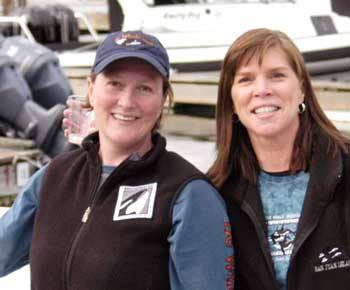‘What is needed now is critical funding for federal and state marine wildlife enforcement efforts’
By Jenny Atkinson and Kari Koski
The Whale Museum applauds NOAA Fisheries for exercising their authority to enact federal vessel regulations for killer whales in Washington State waters.
While we acknowledge that vessel disturbance is but one of the three main threats faced by the endangered Southern Resident orcas, reducing acoustic and behavioral impacts will make important synergistic contributions to the recovery of this important icon of the Salish Sea.
The Whale Museum believes that while whale watching provides crucial conservation, education and outreach opportunities important for marine mammal protection, continued boating pressures and noncompliance with the current “Be Whale Wise Guidelines” and the “Washington State Vessel Regulations for Killer Whales” show a clear need for the new federal regulations.
We fully support both parts of the new rules: prohibiting vessels from approaching any killer whale closer than200 yards and forbidding vessels from intercepting a whale or positioning a vessel into its path.
We are in favor of the 200-yard limit and do not think there is any justification to continue with a “universal 100-yard approach distance”. Endangered species listed populations deserve greater protections from vessels — this includes the Southern Resident orca community.
Recent research indicates that vessel presence in a whale’s path may elicit behavior changes and/or impede a whale’s or group of whales’ ability to capture and/or share prey. We believe there is a clear need to reduce the chance that a vessel in the whale’s path could reduce a whale’s ability to successfully forage during the summer months when salmon are the most plentiful.
The west side of San Juan Island is a critical area for whales as they often travel and forage there. In this highly congested area, boaters are routinely out of compliance with existing guidelines and laws as measured by Soundwatch.
We originally supported NOAA Fisheries’ 2009 proposal to create a Vessel Restriction Area along the west side and recommended an alternative plan that the same area be considered a Special Vessel Management Area (see our 2010 Comments to NOAA http://www.whalemuseum.org/downloads/TWM_2009_NOAA%20Comments_122409.pdf).
While we are disappointed a restricted area was not designated at this time, we are encouraged that NOAA Fisheries has not ruled out the idea of creating a protection area for whales and will consider doing so in future rulemaking decisions.
What is needed now is critical funding for federal and state marine wildlife enforcement efforts. Our Soundwatch program stands ready to help educate boaters about the new regulations both on and off the water this summer.
However, Soundwatch is an education and monitoring program and is not out to enforce the new regulations. We are concerned that the funding needed for enforcement may not be forthcoming with both federal and state budget shortfalls.
The Whale Museum would like to thank the community for continued support of Soundwatch. Donations to help with this summer’s Soundwatch efforts are gratefully accepted anytime.
And if you, too, are concerned about funding for enforcement to provide better protection of our orcas, please let your representatives know.
— Jenny Atkinson is executive director of The Whale Museum
— Kari Koski is program director of Soundwatch




